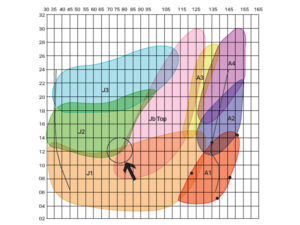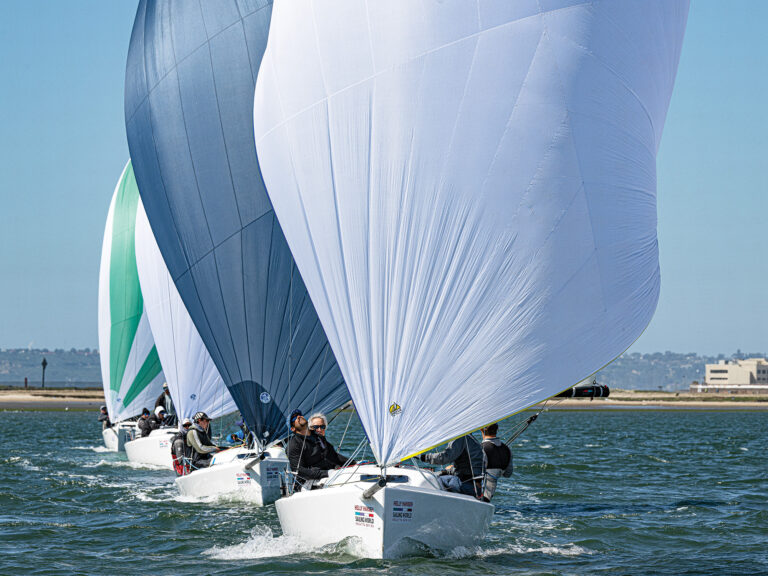The new trend aboard performance boats is to use body energy to impart kinetic energy to the boat so as to propel the boat favorably. Each generation has refined and expanded the techniques to the point where a race could be held in a flooded stadium because wind is not required and, in some ways, is a hindrance to getting around a race course. The following techniques are now an accepted form of the art in most boats:1) Rudders all swept back to the maximum so one can scull more efficiently. This especially helps in the first 50 meters after a start where astute sculling means the difference between getting clear air and being buried. The 470s do it by letting the rudders float up; the Optimists build specially shaped rudders to do the job, as do the Flying Dutchmen.2) Boom vang sheeting is now in vogue. The vang is built to take over all of the functions of the mainsheet except that of moving the boom in a lateral plane. This allows the helmsman to use a 1:1 mainsheet which greatly facilitates pumping. The technique upwind is to pump the main to get the air wedge energy and then, to let it out quickly enough so as to not lose the laminar flow.3) Rocking downwind has been known for a long time. This has now become commonplace upwind so as to drive an air wedge, thus imparting energy to the sail.4) Sailors upwind are now unweighting their boats over the waves similar to what ski racers do over bumps. They raise their bodies up going up the wave and push down going down the wave. 5) Roll tacking has become a major form of propulsion. In the past, good racing tactics have decreed that you would only tack on windshifts because of the loss of speed incurred when going through the eye of the wind. A racer can now gain by tacking rather than sailing on a tack by roll tacking. First, they let the boat heel to leeward, then violently hike, thus bringing the sail over almost to capsize. When the wedge of air is compressed, and therefore the energy maximum, they thrust the tiller over in a violent scull. When the boat is on the other tack, the mast, which is now heeling to the new leeward side, is brought sharply to the vertical position, thus imparting more energy to the rig.6) Sculling upwind with efficient rudders greatly affects the speed. The helmsman sculls sharply into a wave so as to overcome the negative force of the wave, thus accelerating the boat through the wave.7) Pumping downwind is now done in two ways. The crew pumps the spinnaker while on the trapeze to windward while the helmsman sits to leeward, holding the boom with his hand and constantly pumping.8) Downwind, the boat is now steered by shifting the crew weight so as to snake the boat in the following manner: the boat is heeled to leeward, which steers the boat to windward. Then the boat is heeled to weather, which makes the boat lay off. This, coupled with proper wave action and no rudder action, is quite effective.It is a revelation watching the modern sailor simultaneously sculling, rocking, pumping, unweighting his boat, upwind and downwind. To the uneducated, they would immediately suggest that the sailor be committed to an institute for nervous disorders.The Union is now at a crossroads with regard to this issue, and they have two choices: 1) to agree that sailing has changed, and body energy is part of the game. The rule on propulsion should therefore be changed to allow everything but oars and motors. 2) To immediately stop these actions and reinforce the intent that propelling a sailboat can only be accomplished by wind upon sails. This means that the following type rules should be instituted:a) Rudders must be fixed in the vertical plane with a minimum angle of tilt.b) Roll tacking is illegal. The mast must not change attitude more than what would be normal when sailing.c) There must be at least four purchases in the mainsheet and controlled by the tail except when jibing d) Any form of rocking is illegal, and sailors must do everything possible to dampen rolling action.e) Pumping is illegal at all times except in the case of that which is done through the mainsheet to promote planing.Once the terms of reference are defined, the Union should appoint special jury of 20 active and current sailors who would, for a period of two years, police the sport at major championships with the expressed intention of setting a standard for fair sailing.









